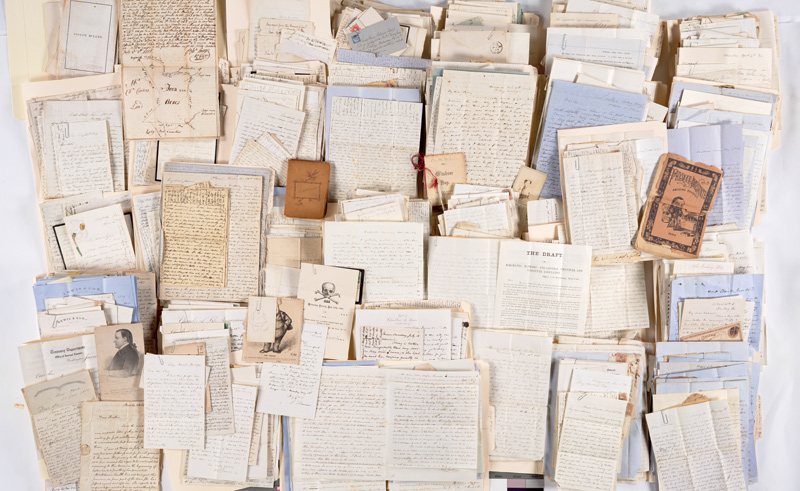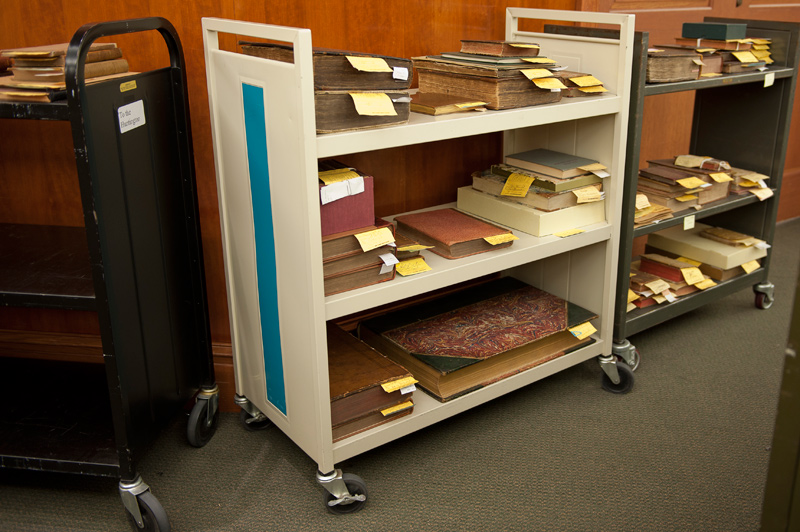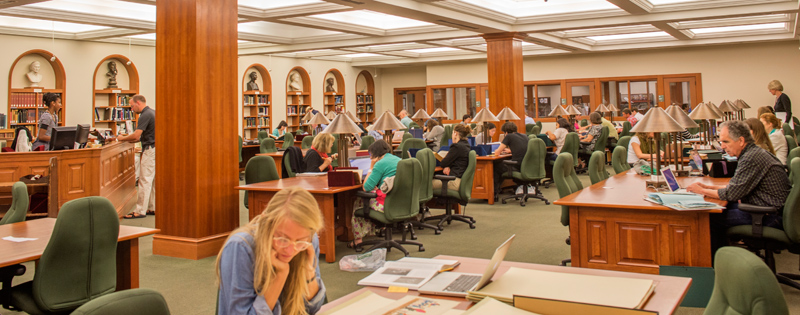The Huntington’s blog takes you behind the scenes for a scholarly view of the collections.
Navigating the Labyrinth
Posted on Wed., Sept. 26, 2012 by

An assortment of rare books and manuscripts from the papers of Charlton Thomas Lewis (1834–1904), purchased by the Library Collectors' Council in 2011.
Eight million manuscripts.
Seven miles of shelving.
A third of a million items used by scholars in a 12-month period.
A snapshot of the scale of the task faced every day by stacks staff of the manuscripts department.
The process starts simply enough. A request slip is filled out by the scholar and turned in to the Ahmanson Reading Room supervisors. The slip is then sent down to the stacks offices, located one level below ground in the Munger Research Center. Once the slip is received, the retrieval and delivery process begins.

Staff members still rely on the card catalog, a tried and true method for organizing the manuscript collections for quick retrieval. Photo by Martha Benedict.
From July 2011 through June 2012, my indispensable colleague Gina Giang and I paged more than 336,500 manuscripts; an increase of 50 percent from the previous year. Last year was the busiest I’ve had since joining the manuscripts department in 2005. Included in those numbers were some record statistics: 50,000 items paged in August 2011, and 48,000 in June 2012. Summer is always the busiest season for paging, with universities out of session; in fact, we hire a temporary employee to help stem the tide during the peak months of June through August.
The manuscripts collections are a literal maze of material—stacks that fill three large rooms in the basement of the Munger Research Center, floor to ceiling; rows of locked aisles in the old Library building (which includes the Main Exhibition Hall), and many other nooks and crannies throughout The Huntington. The collections are also a figurative maze, constantly moving—material goes to scholars, is returned, goes on exhibition, goes to conservators for review or repair, is photographed or digitized, goes to curators, is cataloged, recataloged…the list goes on.

Books and manuscripts, after a full day of use by scholars, await their return to the stacks. Photo by Martha Benedict.
Gina and I keep track of it all on catalog cards. Unlike a rare book or reference volume, manuscripts do not have an easy place for a barcode. While the manuscript department does house thousands of volumes, there are vast collections composed of hundreds of boxes, each box containing hundreds of letters. Such a collection would need a master barcode. Then each box would need its own barcode, and each letter within each box. It is a nice dream, and a dream that will, one day, become reality. Until that day, however, we use the same manual card-based checkout system (complete with date stamp!) that has been in practice since the 1920s.
Sometimes items are misplaced. Other times the location on file is incorrect. Letters seem to move around inside boxes, and volumes seem to shift on the shelves when we’re not looking. Sometimes I wonder if there are mischievous gremlins down here at night.

Scholars in the Ahmanson Reading Room of the Munger Research Center make good use of the collections. Photo by Martha Benedict.
It is challenging work. It can be exhausting physically. Sometimes it feels like Christmas Eve at the mall. I think about wearing a pedometer. It can be exhausting mentally. Request slips can be confusing, incomplete, or inaccurate. It is a combination of detective work and educated guessing. It is managing workflow, and managing personalities. It is a subtle art, and a highly organized science.
But it is also deeply rewarding. Gina and I get to see and handle treasures on a daily basis, and connecting scholars with the materials they need for their research is incredibly fulfilling.
Under the Ahmanson Reading Room lies a labyrinth, and every day, my trusty colleague and I happily navigate it with speed and precision.
Bert Rinderle is stacks supervisor in the manuscripts department at The Huntington.